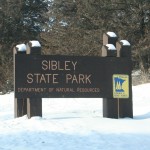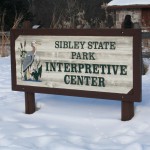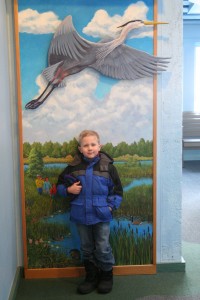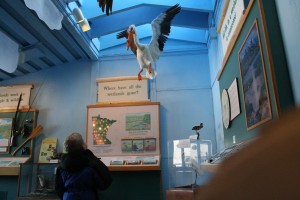 Today Evan and I fed our birding habit by attending a bird feeding seminar at nearby Sibley State Park. Since there aren’t as many species around in the winter as there are in the summer and since it’s hard to get out birding, we thought it would be a good idea to take in this seminar to see what we could do to enhance our birdwatching from the comfort of our own home. The great thing about Minnesota’s state parks is that they have all kinds of programs througout the year. All of these activities are placed on one calendar at the DNR’s website. (Click here to access it.) The cool thing about this calendar is that Evan and I can see what birding programs are offered at any of our Minnesota’s 67 state parks.
Today Evan and I fed our birding habit by attending a bird feeding seminar at nearby Sibley State Park. Since there aren’t as many species around in the winter as there are in the summer and since it’s hard to get out birding, we thought it would be a good idea to take in this seminar to see what we could do to enhance our birdwatching from the comfort of our own home. The great thing about Minnesota’s state parks is that they have all kinds of programs througout the year. All of these activities are placed on one calendar at the DNR’s website. (Click here to access it.) The cool thing about this calendar is that Evan and I can see what birding programs are offered at any of our Minnesota’s 67 state parks.
Sibley State Park was alive and well today as people took advantage of this beautiful, sunny day by skiing, sledding, or staying in one of the park’s camper-cabins. Not many people, however, attended the bird-feeding seminar at the park’s interpretive center. It was Evan and me and one other family group. That was fine with us. The park naturalist, Dick, gave about an hour long presentation on winter birds, their habits, and how best to feed them. At the beginning of his slideshow he would put a bird picture on the screen and ask if anyone knew the name. Of course we knew them, but Evan can be quite shy and therefore wasn’t answering Dick. After a nudge or two from his dad, he finally started identifying every bird correctly. Later on I was visiting with Dick who commented on how remarkable it was that someone Evan’s age knew so many bird species. He told me most adults he runs into can’t identify birds that they see.
Rather than giving you a complete summary of Dick’s talk, I thought I’d share with you my exit slip from his talk. In the education world, an exit slip is a person’s own take-aways from a lesson. It contains the information the student found most important.
- Minnesota has 400+ bird species; 206 have been found at Sibley
- Only 44 bird species show up at feeders in MN in the winter; only 12-15 show up in our area (That’s a bummer because I think we’ve had them all already and can’t really expect many new ones, but at the same time it’s cool that we are seeing all that we can.)
- Bird feeders should be placed on the south or east side of your house
- Black-oiled sunflower seeds are the only kind of seed you really need, though some species do like milo, cracked corn, and thistle
- There are more thistle-feeding birds in the winter than in the summer (Goldfinches stick around, though they are more greenish than bright yellow)
- Birds are attracted to water, and there are plug-in, winter water features available for purchase (we will probably buy one this week)
- All four niches of bird feeders should be used to maximize your birdwatching experience: tabletop feeders, hanging feeders (suet and thistle), tree-trunk suet feeders, and seeds on the ground



You must have had a good day. You are making me want to fill our bird feeders but I think we only get about three different kids of bird at our house. I have been keeping grandma Evelyn’s full for her being she only has one hand. I think it is great Evan that you and dad are bird watchers. It will be lots of fun when you go camping to see what you can find. Evan you are amazing at what you know about birds. Love you, Grandma Brenda
You should fill up those feeders – I bet the girls would get a kick out of it (and you guys too!). You’ll get a lot more than three kinds, especially if you do sunflower seeds and suet. Plus you get some cool ones that we don’t, like the pine and evening grosbeaks. Thanks for stopping by, I’ll pass your note on to Evan.